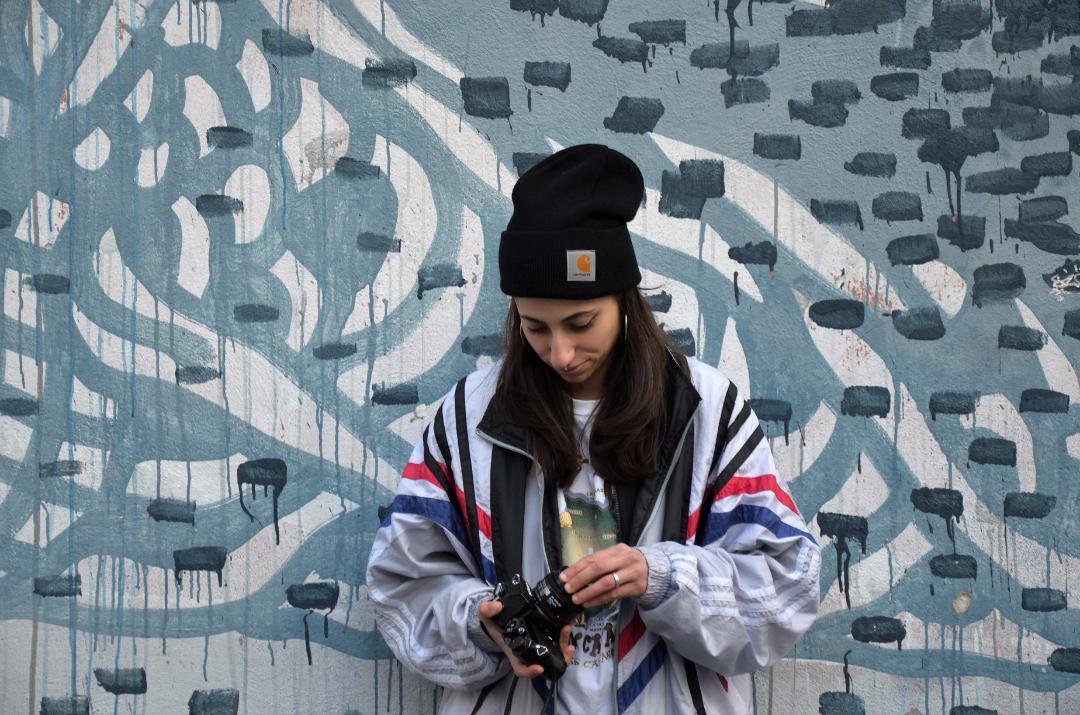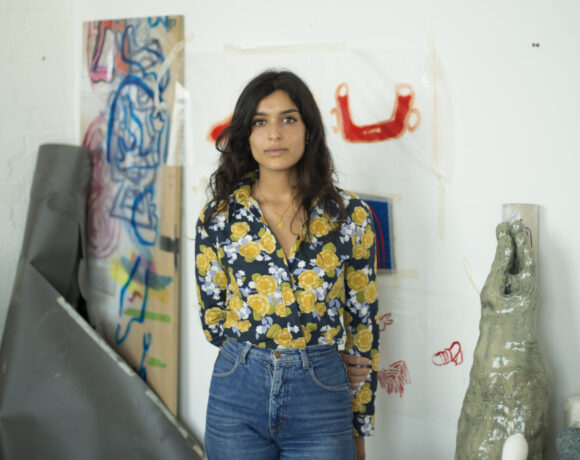From 20 to 25 June, the Academy of Fine Arts in Bologna presented the ninth edition of Opentour, curated, for the second consecutive year, by Carmen Lorenzetti and Giuseppe Lufrano. A one-of-a-kind project, as Rita Finzi, president of the Bologna Academy of Fine Arts told us during the press conference: «The students leave the classrooms of the academy and enter the fray, face to face with gallery owners, critics, collectors and the public. This is a very important educational experience. The unique academy of Bologna in Italy has included this moment in the training path of its students and this has been possible also thanks to the great and participatory collaboration of the city’s gallery owners».

Opentour, 2023, photo courtesy Accademia di Belle Arti di Bologna
Therefore, not only exposure within the institution venue, but also outside, in the streets of the city; «28 between galleries and private spaces, each of which hosts a specific exhibition: absolute protagonists, the works of male and female students of the two-year specialist courses and the last year of the three-year courses». The tour inside the Academy will be visible until July 1st and I strongly advise everyone to start right from the place where everything was conceived and created. In addition to the exhibitions, in fact, very interesting for the public will be the possibility of being able to observe with their own eyes the classrooms and laboratories where the works were created by the students before being exhibited: sculpture, graphics, comics, painting, photography, design, fashion and from this year also the metaverse. «Opentour is confirmed as a beautiful and joyful celebration of art» as stated during the press conference Cristina Francucci, director of the Academy of Fine Arts in Bologna. And this is exactly the air that one breathes inside the institution and in the streets of the quadrilateral, strolling with the Opentour map in hand in search of exhibition venues.

Opentour, 2023, photo courtesy Accademia di Belle Arti di Bologna
The opening of Young talents in the gallery took place on Thursday 22 June. Furthermore, many galleries will host the works of the youngsters beyond the end of June. To name a few, among those that personally struck me the most, we find that of Alchemilla 43 (which can be visited until 29 June). Guests of the exhibition, curated by Ivana Spinelli, the artists Ylenia Joiner Santuario, Chiara Marchesi and Giacomo Mallardo from the three-year period sculpture course. The exhibition named ø is a reference to the mathematical symbol that indicates the empty set, «if one thinks of the mathematical set as space, one can think that this indicates the disabled, free, deserted. The works seem to be placed on the sidelines, where the edge is understood as a place of possibility». The first visible work upon entering Alchemilla is that of Ylenia Santuario Joiner, entitled 105.001. The work focuses on the concept of self-loss, elaborated through hair loss that occurs in the shower. In the installation, the hair is hung from drip wires, wet and fed with continuous water. All this reproduces the sense one has of wet hair in the shower and of the drip that occurs automatically. A magnificent sense of emptiness and uncanny feeds the viewers. “As long as it’s on the head it’s important but then what?” Ylenia asks us, giving way to the work Untitled by Chiara Mareschi. Installation entirely centered on the concept of subordination. The gallery, in fact, finds itself, thanks to the artist, totally contaminated by colonies of mushrooms made of wax and aluminum. A real contradiction: the mushroom, whose existence can only depend on other organisms, is found here instead to have a life of its own. The latest work entitled Blu che tende al bianco e viceversa by Giacomo Mallardo is a game between two embroidered fabrics, placed in the center of one of the halls of the residence: the dialectical relationship between introversion and communicative need is at the center of the reflection.

Giuseppe Francalanza, Disertori, 2023, photo courtesy Studio la Linea Verticale
Continuing through the galleries, I cannot fail to mention Studio La Linea Verticale which presents the two-person show Virati l’ha nel foho. «Fire is identified in the exhibition as a symbol of work by energy in Greek, in fact, energheia means at work in action», and it is chosen as a connecting element between the two artists on display: Giuseppe Francalanza and Jacopo Risaliti. Therefore, in the two rooms of the gallery, the sculptures by Risaliti and the painting by Francalanza are in dialogue. The marble worked by the first artist becomes the spokesperson, sometimes thanks to the use of soot, of movement, change and the concept of work. In Giuseppe’s painting, on the other hand, the scorching sun corrodes and silences a life clearly teeming beneath it. It can be visited until 15 July 2023.

Francesca Rinaldi, Lieto e Triste (dalla serie “ricostruzioni metamorfiche”), 2023, dimensioni variabili, sasso, argilla, gesso, photo courtesy CAR Gallery
The third gallery that we cannot fail to mention is CAR Gallery with its Keramikos (on display until 9 September). In this case, the exhibition curated by Andrea Busto (director of MEF Turin) and on the recommendation of the professor of the Bologna Academy Carmen Lorenzetti, invites the student Francesca Rinaldi to engage in dialogue with the project, thinking of a series of new works created specifically for installation. «Keramikos records the extreme vitality of the current production of ceramic works with the presence of 20+1 international contemporary artists. The starting points are T42 by Mona Hatoum and Coppette by Fausto Melotti, works that are diametrically opposed in terms of poetics and research». Ricostruzione 1 and 2 made with stone, clay and plaster reflect on the concept of metamorphosis. As the artist specified: «This transformation is for me the freedom of being; the form breaks its cage and becomes what is most necessary for it».

Wang Xiaoxin, Bestia mitica della scoreggia, 2023, photo courtesy OTTO Gallery
At Otto Gallery, on the other hand, we find Identità Dissimili, curated by Giuseppe Lufrano (open until 30 June). The project, among the most extensive, hosts six students from the two-year course in Visual Arts – Painting, who have attended the courses in Economics and the art market and Preparation of exhibition spaces and have been placed in a professional context where they can try linguistic experiments and exhibition methods. The invited artists are: Sofia Fadda, Gloria Franzin, Filippo Mestroni, Miriam Spaggiari, Giorgia Toselli and Wang Xiaoxin.

Ri-tessere ad arte | Crossing Threads, laboratorio di fashion design, ph. Eleonora Piras, courtesy Accademia di Belle Arti di Bologna
Among the events and initiatives launched by the academy, 2023 also saw the unfolding of RiparAzioni, conceived for the PON Metro programme, the National Operational Program for Metropolitan Cities, coordinated by the Municipality of Bologna and financed by the European Union, which intends to promote generative welfare with actions aimed at acquiring a critical conscience and greater awareness of social exclusion and the creative responses that art with its languages can offer. «The title is inspired by the Japanese art of Kintsugi, a repair system using resin and gold dust that highlights cracks and fractures of broken objects, whose fragility is exalted, embellished and not hidden. The metaphorical meaning of this technique recalls the concepts of resilience and rebirth starting precisely from those fractures, personal and social, which, only if they become visible and shareable, can be overcome by transforming themselves into occasions for conscious regeneration, both individual and collective». There were many initiatives within RiparAzioni: talks, workshops, events, an installation, an exhibition, a book, a comic strip, a fashion show and a film.

Flavio Favelli, Pulpito e altre figure, Piazza Roberto Raviola, Bologna. ph. Martina Platone, courtesy Accademia di Belle Arti di Bologna
The talks that took place from 3 April to 23 June saw great protagonists of art and culture such as: the philosopher Emanuele Coccia, the artistic collective ruangrupa, the theater director and playwright Armando Punzo, the artist Adelita Husni-Bey, the illustrator Nora Krug and director Alice Rohrwacher. As for the installation, exhibited in Piazza Raviola, it is the work of Flavio Favelli. The sculpture is the representation of multiple stages united and converging and which, in some way, offer passers-by the possibility of being able to dialogue with the surrounding space but also becomes a bridge that unites the “activities of the academy with the surrounding environment”. On the other hand, on Saturday 17 June, still in Piazzetta Raviola, the male and female students of the Fashion Design course made the clothes created by them visible to the public with a fashion show called: Crossing Threads. The call to the parade was also extended to citizens and townspeople residing in the neighborhood.

Federica Casadei, Sazietà, frame video, La casa nel piatto, RiparAzioni, 2023, photo courtesy Accademia di Belle Arti di Bologna
Back, for its second edition, La casa nel piatto, curated by Giovanna Caimmi and Valerio Dehò. The exhibition was born from the idea of bringing together clochards from Bologna, thanks to the support of ASP Bologna, with students from the Visual Arts MA (in particular from the photography MA). «At the basis of this project there is a choice, that of considering art also as an educational tool, therefore not only a text to study and analyze, but a pretext to strengthen one’s emotional and imaginative resources». The male and female students had the opportunity to meet and interact with homeless people, using food as a mediator, going to the canteens and participating in the preparation of meals. Each of them has reinterpreted these meetings with different artistic means and techniques and the results have been exhibited in the exhibition at the Complesso del Baraccano visible until 8 July. In addition to an exhibition, the project has also generated a film, entitled La città di cartone, by Maurizio Finotto, in collaboration with the students of the Cinema and Audiovisual Languages Course. The story is about a cardboard city, «a parallel and semi-invisible city populated by people who have no home. This second city extends into the dark corners, the dead zones, the interstices of the periphery. The settlements can be similar to a small apartment, but virtual: kitchen, living room, bedroom, but with transparent walls, only imagined, as well as the entrance, the doors, the ceiling, which can be the sky».
Info:
www.ababo.it/activities/riparazioni
www.ababo.it/activities/opentour/opentour-2023

She was born in Genoa but currently lives in Bologna, the city where she graduated from CITEM with a thesis on video art. She works in the world of events in the production sector and is an assistant professor of Visual Studies at UNIBO.






NO COMMENT